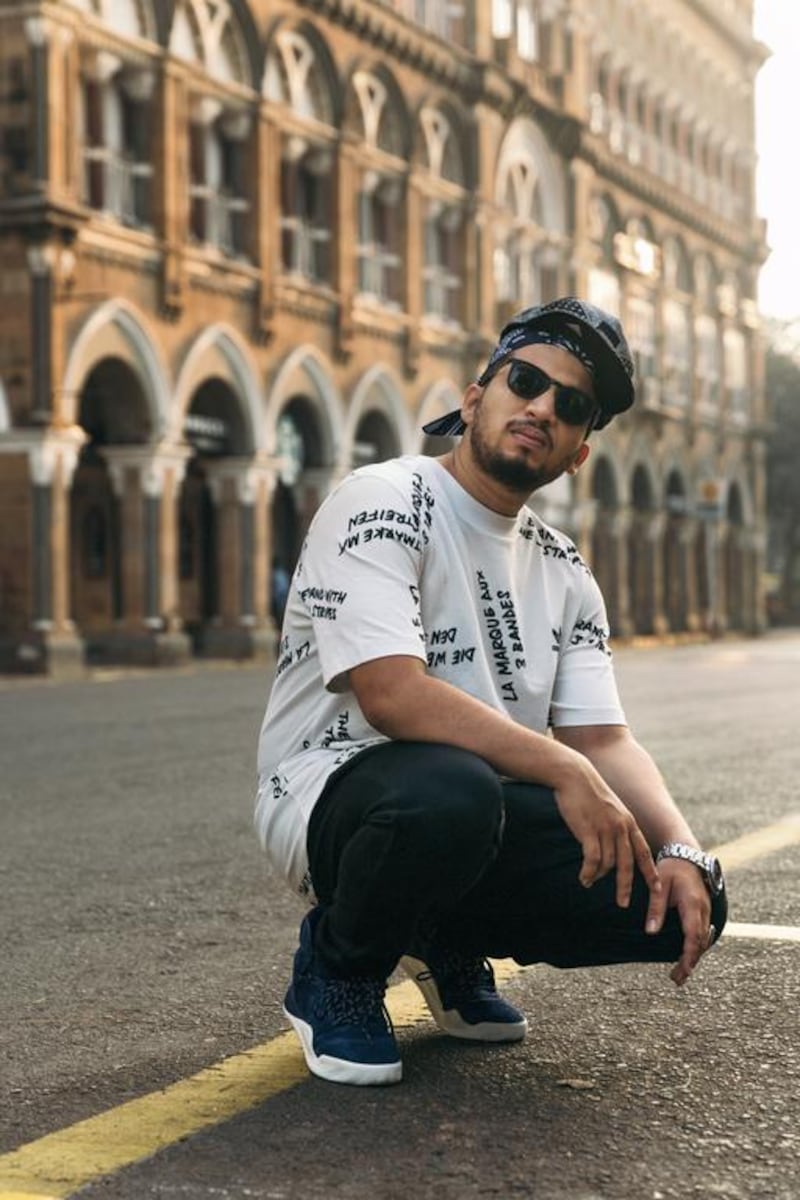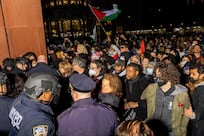“One day a contract killer turned up at our house. Gangsters had hired him to kill my grandfather,” Naved Shaikh tells me, as we sip chai at a tea stall next to the Kurla West slum where he grew up. Like the many working class enclaves that dot Mumbai’s urban landscape, this is a rough neighbourhood.
But its narrow streets – gully, in local parlance – used to be rougher. In the 1980s and 1990s, Kurla West was run by gangsters, engaging in violent turf wars when they weren’t busy extorting money from its working-class residents. A well-respected community elder, Shaikh’s grandfather had tried to organise the residents to stand up to the local mafia, earning him the visit from a knife-wielding assassin.
“When he burst into the house, he came upon my grandfather reading the Quran,” says Shaikh. “He was a Hindu but he was so touched that he decided to spare my grandfather. Then that same guy got knocked off a few days later.”
Even today, the streets of Kurla can offer an easy entryway into the world of organised crime. Youngsters are recruited into gang life early. “Little soldiers”, Shaikh calls them, before admitting that he too used to be one of the chawl’s (tenement) little troublemakers. With an absent father (off to Dubai to earn money), Shaikh spent much of his early life on the streets. But a few hours in the local police station – and a beating by the cops – convinced Shaikh that he needed to get out. “I realised that if I continue down this path, I’ll be stuck here forever,” he says.
For Shaikh, that way out was hip-hop. Adopting the stage name Naezy the Baa, he started writing and honing his skills on the mic through freestyle rap 'cyphers', or jams, with a group of friends at a tea stall near his college. When his father bought the family an iPad so they could talk via Skype, he used it to record his first single. Called Aafat, the track features Shaikh rapping in his signature blend of Urdu, Hindi and Mumbaiya street slang over a shuffling, minimal beat.

Divine (Vivian Fernandes), a rap artist from Mumbai. Courtesy Sony Music
The lyrics paint a scathing, satirical portrait of life on the streets – strutting gangsters, corrupt politicians, the crabs in a bucket mentality that keeps people trapped in unfulfilling lives. Through it all runs Shaikh’s determination to beat the odds and live his life on his own terms.
On January 1, 2014, Shaikh put the song on YouTube. That’s the moment when everything changed. Striking a nerve with an audience largely unrepresented in mainstream culture and music, the song racked up more than a million views and catapulted Shaikh to the forefront of Mumbai’s burgeoning hip-hop scene. A year later, he was signed to indie music conglomerate Only Much Louder and performing in front of 20,000 fans screaming at Pune’s NH7 Weekender festival.
Shaikh’s meteoric rise is one of the more visible indications of a slow-burn revolution that is taking place in Mumbai’s working-class neighbourhoods. Shut out of mainstream culture, often dismissed as goondas (gangsters) and taporis (thugs), working-class kids from Kurla, Andheri and Dharavi are finding expression in a small but growing hip-hop scene – not just as rappers but also as B-Boys (breakdancers), graffiti artists, DJs and beatboxers.
The art forms and the fashion may be borrowed from black American culture but the stories are local. Class-conscious and politically-aware, their music shines a light into the darker corners of urban life – crime and corruption, dehumanising poverty, divisive politics and the ever-present need to hustle to stay afloat.
They speak of hip-hop not as entertainment but as a movement, and view themselves as truth-sayers, chronicling the stories of the disaffected and the disenfranchised. “The stories that don’t reach the mainstream, or the ones which don’t get accepted by society, are now being heard and accepted through the medium of rap,” says Shaikh.
Largely DIY and independent, the scene has caught the attention of music labels and Bollywood. There’s a big-budget feature film in the works based on the lives of Shaikh and his fellow “gully rap” star Divine, and labels are falling over each other to sign the next rap sensation.
"The reason the labels and Bollywood are coming in now is because they know we are speaking directly to the people," says Vivian Fernandes, aka Divine, who is signed to Sony Music and is the current poster-boy for Mumbai rap. With hit singles such as Farak and Jungli Sher, Divine has struck a chord. His raw and brutally honest Hindi rap draws inspiration from his own life – growing up alone in Andheri's slums, with his mother and brother working abroad and an abusive father who one day disappeared from their life. "We are the voice of the people and they recognise that."
The origins of Mumbai’s rap scene date back to the mid-2000s, when the global success of American rappers such as Eminem and 50 Cent inspired youngsters in India. One of the first rap crews in the city was “Mumbai’s Finest”, which started in 2006. They would spit rhymes at each other in small groups on the streets, take part in text battles on their phones and record their efforts over beats stolen from the internet using cheap headphone mics.
A couple of years later, a group of kids in Dharavi – a major epicentre of this new movement – started another crew called SlumGods, a collective of dancers, beatboxers and rappers who spent their time training younger kids in hip-hop in an attempt to keep them off the streets.
This first generation of local hip-hop artists – including Poetik Justis, Enkore, D’Evil and many more – spent much of their time learning how to self-produce. They organised small DIY rap events, started labels and helped each other grow from amateurish imitators to accomplished wordsmiths.
Slowly, Mumbai hip-hop went from a pipe dream to an independent subculture with its own icons, history and underground infrastructure. “We used to have cyphers, where we used to meet people and among ourselves battle and among ourselves freestyle just for the fun of it, to keep the essence alive, and know that we are the few people that are actually doing it,” remembers Abhishek Dhusia, aka Ace. Ace founded Mumbai’s Finest, and is one of the city’s oldest rap veterans. “We never thought it would actually be profitable but we did it anyway.”
But there was one thing still holding the scene back – the fact that almost everyone still rapped in English, although for many it wasn't their first language. That changed in 2013, when Divine released the Mumbai rap anthem Yeh Mera Bombay, sung entirely in Hindi. The song racked up 100,000 views in two months – a big number for the time but more importantly, it showed that rapping in local languages opened the doors for a much bigger audience.
Pretty soon, everyone was ditching their hard-earned American accents. In Dharavi, crews like SlumGods and Dopeadelicz were dropping rhymes in Tamil, Malayalam and street Hindi. The five-member crew Swadesi raps in Hindi, Gujarati, Tamil and Bengali. This rainbow of language and slang not only showcased the diversity of cultures and peoples that populate working-class Mumbai, it also allowed the rappers to take their socio-political commentary and their dreams of cultural revolution to the people around them.
“When we started putting in local slang and rapping in local languages, people started to understand us better and that created a connection,” says Tony Sebastian aka Stony Psyko of Dharavi rap pioneers Dopeadelicz, whose songs tackle issues such as police brutality.
“A lot more kids started rapping and those who couldn’t rap took up B-boying [breakdancing], graffiti or other elements of hip-hop culture.”
The scene also got a big push over the past few years because internet connectivity breached a critical class barrier thanks to the ubiquity of smartphones and cheap mobile data. Cheap and free (pirated) recording software made it easy for people to make tracks and upload them to YouTube; online rap communities shared and dissected each new release relentlessly, their digital evangelism bypassing traditional marketing and media to reach out to hundreds of thousands of kids all over the country.
All it needed was that one big hit, the track that tied together the multiple strands of Mumbaiya rap and presented it to the wider world. That came in the form of Divine and Naezy's collaboration Mere Gully Mein (In My Streets), a joyful celebration of Mumbai street life, accompanied by a video shot in the narrow bylanes of Dharavi. Released on Sony in 2014, the track was an instant hit. Mumbai rap had finally arrived.

Tony from rap group Dopeadelicz in a still from documentary Dhavari Hustle. Screen grab of Dopeadelicz
Since then, the scene has been in consolidation mode. As Naezy and Divine put out single after single, new challengers for their crown have emerged – whether it was newcomers like Swadesi and 5 Dawgz or re-energized veterans like Ace and Poetik Justis. Bollywood may be knocking on their doors with the lure of a big paycheck but they remain committed to building an independent identity on their own terms, wary of co-option by a fickle and money-minded film industry.
Instead they have formed alliances with smaller labels and artist management firms who understand the music. They are starting to plug into India’s live music circuit, performing in nightclubs and festival stages to legions of fans who know the words to every song. And they are developing their own individual styles and variations on the Mumbai rap sound – gritty, raw and bluntly satirical.
Many of the artists I spoke to – Naezy, Divine, Ace – are working on full-length albums and EPs, promising a glut of original and independent Mumbai rap in 2017. The future of Indian independent music, they believe, is hip-hop.
“I’ve seen us go from literally playing for five people to 15,000 people,” says Fernandes, echoing the euphoric optimism of everyone I spoke to.
“The first beat I ever used for a freestyle was a rap beat by DJ Premier and I got to open for him at Weekender last year. That was the best feeling in the world.”
Bhanuj Kappal is a freelance journalist based in Mumbai who writes about music, protest culture and politics.





